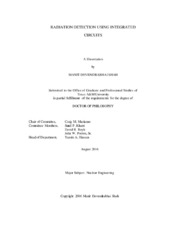| dc.description.abstract | The research objective of this dissertation is to evaluate the capability of ‘radiation’ integrated circuits (RICs) to serve as a new type of radiation detection medium. Designed at Texas A&M University, the RIC contains both radiation-sensitive areas (RSAs) and radiation-hardened areas (RHAs). RSAs are designed so that their electrical properties change when exposed to charged particles. RHAs monitor such changes in RSAs to detect the presence of radiation. Novel detector designs utilizing the RICs were assessed and optimized, using both analytical and simulation methods, to register the major types of radiation: alpha particles, beta particles, gamma rays, and neutrons. The detector system materials and components were varied to characterize different configurations and recommend optimized RIC detector designs.
The proposed revolutionary RIC-alpha/beta probe design has two regions: one to detect alpha particles and another to detect betas along with their Eβmax (maximum beta-particle energy). In order to perform the Eβmax discrimination, the maximum penetration depth property of betas in the attenuator was utilized. In MCNPX, plate glass, Pyrex® glass, Lucite®, and natural rubber were studied as attenuator materials. For the proof of concept, attenuator materials in the shape of a wedge were analyzed. The natural rubber in the form of a wedged attenuator was observed to show superior Eβmax discrimination compared to other defined attenuators. The Eβmax resolution capability of 50-keV is possible using natural rubber attenuator.
The proposed RIC-neutron detector design uses enriched boron (96% 10^B) as a neutron-reactive coating to generate secondary charged particles. In MCNPX, other neutron-reactive materials (natural boron, B4C, and LiF) were also studied. Analysis showed that compared to other charged particles, alpha-particles were the major contributor to the signal generation in RSAs designed to detect neutrons. With the optimal thickness of 3-µm enriched boron, the signal to noise ratio for thermal neutron detection was increased by approximately three orders of magnitude.
The proposed RIC-gamma ray detection system uses a sodium iodide crystal, photocathodes, and the RIC. Unlike the traditional design, the proposed approach places photocathodes on all crystal surfaces to collect optical photons and generate photoelectrons. These photoelectrons interact to generate an electrical signal in the RSAs, and thereby the RIC detects gamma rays. The collection ratio (i.e., the number of collected optical photons under the proposed design compared to the number using a traditional design) was found to be a function of the crystal size, gamma-ray energy, and the source position. The concentration of photoelectrons as a function of the RSA radius size was also assessed to optimize the RSA size. | en |


